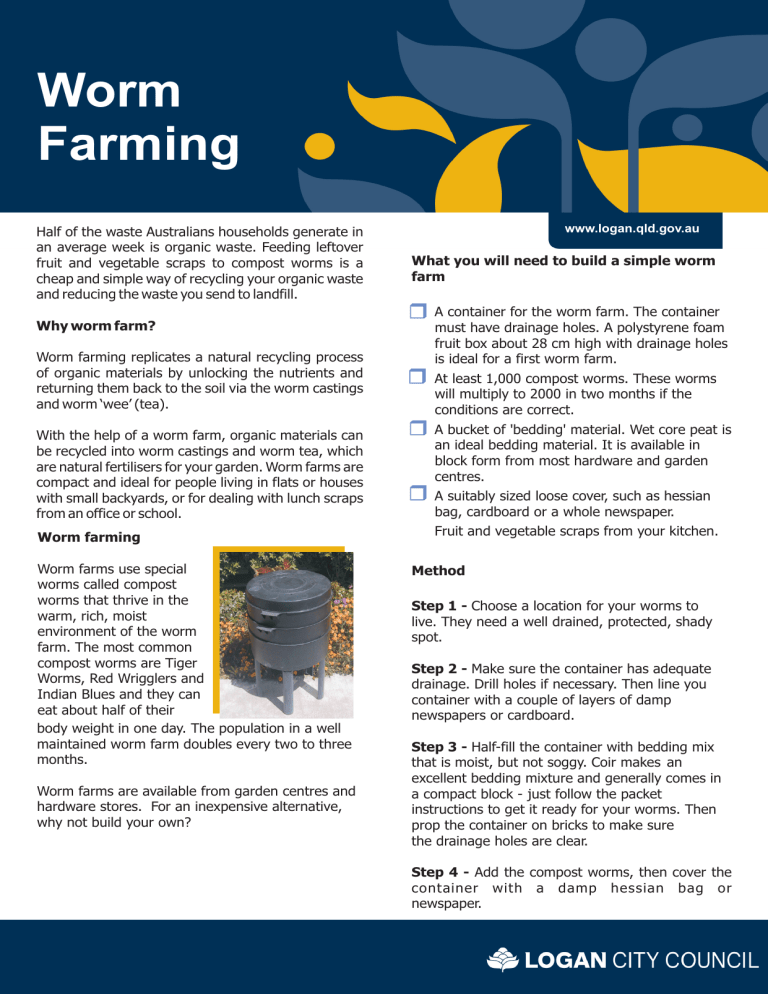
Worm
Farming
Half of the waste Australians households generate in
an average week is organic waste. Feeding leftover
fruit and vegetable scraps to compost worms is a
cheap and simple way of recycling your organic waste
and reducing the waste you send to landfill.
Why worm farm?
Worm farming replicates a natural recycling process
of organic materials by unlocking the nutrients and
returning them back to the soil via the worm castings
and worm ‘wee’ (tea).
www.logan.qld.gov.au
What you will need to build a simple worm
farm
A container for the worm farm. The container
must have drainage holes. A polystyrene foam
fruit box about 28 cm high with drainage holes
is ideal for a first worm farm.
At least 1,000 compost worms. These worms
will multiply to 2000 in two months if the
conditions are correct.
A bucket of 'bedding' material. Wet core peat is
an ideal bedding material. It is available in
block form from most hardware and garden
centres.
With the help of a worm farm, organic materials can
be recycled into worm castings and worm tea, which
are natural fertilisers for your garden. Worm farms are
compact and ideal for people living in flats or houses
with small backyards, or for dealing with lunch scraps
from an office or school.
A suitably sized loose cover, such as hessian
bag, cardboard or a whole newspaper.
Worm farming
Fruit and vegetable scraps from your kitchen.
Worm farms use special
worms called compost
worms that thrive in the
warm, rich, moist
environment of the worm
farm. The most common
compost worms are Tiger
Worms, Red Wrigglers and
Indian Blues and they can
eat about half of their
body weight in one day. The population in a well
maintained worm farm doubles every two to three
months.
Worm farms are available from garden centres and
hardware stores. For an inexpensive alternative,
why not build your own?
Method
Step 1 - Choose a location for your worms to
live. They need a well drained, protected, shady
spot.
Step 2 - Make sure the container has adequate
drainage. Drill holes if necessary. Then line you
container with a couple of layers of damp
newspapers or cardboard.
Step 3 - Half-fill the container with bedding mix
that is moist, but not soggy. Coir makes an
excellent bedding mixture and generally comes in
a compact block - just follow the packet
instructions to get it ready for your worms. Then
prop the container on bricks to make sure
the drainage holes are clear.
Step 4 - Add the compost worms, then cover the
container with a damp hessian bag or
newspaper.
Worm
Farming
continued...
www.logan.qld.gov.au
Step 5 - After one week, place some fruit and
vegetable scraps into one corner of the worm farm.
Avoid placing the following in a worm farm:
Step 6 - Continue to add fruit and vegetable
scraps each week, placing the food in
different corners of the worm farm each t i m e . I f
uneaten food remains after 5 days, then you know
you have overfed the worms.
meat products
Step 7 - After feeding the worms, cover again
with the damp hessian bag or newspaper to avoid
attracting vinegar flies.
large quantities of bread
Step 8 - Add water when necessary to prevent the
worm farm from drying out. It is important to keep
the worm farm moist, but not soggy.
Step 9 - Your worms will produce castings and
worm tea. It is these by-products that you can use in
and on your garden in the same way as compost, or
mixed with commercial potting mixes to pot plants,
and liquid fertilisers.
dairy products
oily products
onions, garlic and citrus fruits
Worm farm trouble shooting
You need to make sure you have the right balance of
organic materials, moisture and air to have a
successful worm farm environment. If you have a
problem, the following chart may be of assistance.
Problem
Causes
Solutions
Strong, bad
smell
Not enough air
circulation
Fluff bedding & make sure
bedding or compost is not
blocking the air holes.
Too much food
in bin
Feed worms less food and/or
less often.
Improper food
added
Remove meat, dairy and oily
products.
Anaerobic
conditions
Add some dry bedding to
absorb moisture.
Food exposed
Cover food and bedding
completely.
Too much food
Feed worms less food and/or
less often.
The right worm food
Worms will eat almost anything, however like us there
are things that are good for them and things that are
not:
Fruit flies
You can place the following in a worm farm:
fruit and vegetable scraps
Ant infestation
Dry conditions
Bedding may be too dry,
dampen with some water.
egg shells
Mite infestation
Mite population
is high
Avoid adding foods with high
moisture content, such as fruits
and vegetables.
Overly moist
Too much water
added to
bedding
Stop adding water & add some
shredded paper to soak up extra
moisture.
Too much food
with high
moisture content
Put in less fruit and vegetable
waste and add some shredded
paper.
shredded paper products
fallen leaves
tea bags
coffee grounds
lawn clippings and weeds
